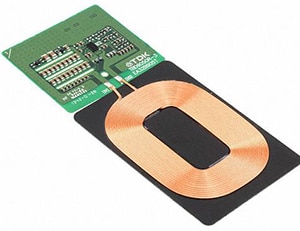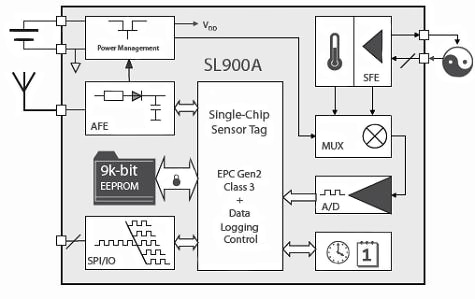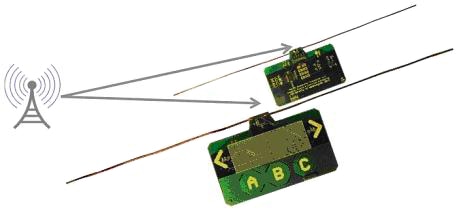RF Energy Harvesting: Batteries Not Included
投稿人:电子产品
2015-10-01
We have all heard the expression that there is energy in the air. Most people associate that with excitement and enthusiasm, but in reality, there is energy in the air as per its definition: power derived from the utilization of physical or chemical resources providing the capacity to do work. From a purely physics point of view, as long as something is not at absolute zero, it has energy. From a classic Newtonian point of view, the multitude of photons, electron, gas molecules, and particles in motion all have energy. From an Einsteinian point of view, the mass of the air’s molecules translates into E=MC2 energy.
Better still, all these naturally occurring sources of energy are joined by our modern RF technology that pumps millions of watts into the atmosphere. This RF energy is steady state in distinct bands like AM and FM, and even within a wider bandwidth for spread spectrum—as long as your tuned circuits can extract usable energy from the electromagnetic fields associated with RF transmissions.
This article looks at energy harvesting from RF signals and how this can be used to power a multitude of wireless and distributed sensors, radios, and IoT-connected monitoring devices. All parts, data sheets, tutorials, and development kits referenced here can be found online at DigiKey’s website.
Space utilization
The notion that “smaller is better” may be true if you are developing ICs for handheld devices, but smaller is definitely not always better when it comes to energy harvesting of RF energy, where surface area or cross-sectional areas are proportional to the amount of energy that can be gathered. Larger antennas, for example, can be used to increase the picked-up signal strength. In some cases, antenna arrays can be built into a structure and will not be a visual detraction. It is even possible to weave antenna arrays into wallpaper or textiles.
What is more, there is no reason that concentrators cannot be used, especially in the corners of rooms. Simple reflectors can multiply the effective surface area to present more concentrated energy to the actual pickup points. Think of it as a low resolution finite element parabolic dish. This approach becomes even more appealing when you have a clear line of sight to a wireless energy transmission source.
This brings up another point to consider when harvesting RF energy to power electronic circuits and sensors. If there is not enough ambient RF energy from local sources, we can design exciter transmitters that can be used to power an array of distant sensors. Each sensor can then communicate back wirelessly. The benefits of ultra-high electrical isolation can allow these types of wireless energy harvesters to attach directly to very-high-voltage power lines, for example.
The actual capture element can be an antenna, an antenna array, or an inductive coil. When tuned correctly, a coil can very effectively transfer energy wirelessly. An interesting point to note is that it is possible to extract energy wirelessly when there are no RF sources. A guitar pickup, for example, will pick up the energy from close proximity metallic vibrations. Also, as many non-humbucking guitar players know, it will also pick up wideband RF energy and even radio station signals.
In other cases, flat planar coils can be mounted behind a thin protective layer that does not attenuate RF energy. Typically, the larger the diameter, the longer the wavelength; and each successive wrap of the antenna coil is additive to the energy extracted.
Design engineers can always design their own custom coils for the best fit, or use pre-made coils and coil assemblies. One avenue is to use coil assemblies designed for close-proximity wireless charging. These can be adapted to extract RF energy from different bands if coupled to a low-loss tuning circuit and when in the presence of enough signal to extract. Receivers can maximize extracted signal by using more coil turns and larger cross-sectional areas so single-coil assemblies or modules like the TDK WT-505060-10K2-A11-G and WRM483245-15F5-5V-G, respectively, can be used here (Figure 1). These can easily mount to your own panels as transmitters or as receivers.

Figure 1: Planar pre-fabbed coil assemblies can be used to create close proximity, electrically isolated power transfers to wireless sensors such as for through-wall sensing.
Multi-coil assemblies like the Wurth Electronics 760308104119 can extract more energy from an aligned source, and can be used to provide truly isolated and independent energy for a microcontroller and an analog-signal stage, for example. Note, any planar transmitter and receiver should be oriented perpendicular to the direction of wave propagation. A through-the-wall type of isolated wireless sensor using these coils can allow chemical warehouses to monitor for explosive conditions using no active energy sources within its closed volume.
Harvest time
Once you have established an energy-capture technique and are capturing raw, un-conditioned power, parts like Texas Instruments' Specialized Power Management ICs can condition that power into useable form. A good example is the TI BQ25570RGRT, which can extract as little as 488 nA of current and make it usable. An initial cold-start voltage of 330 mV will trigger this combined boost/buck regulator with efficiencies up to 93 percent (Figure 2). Once activated, usable power can be extracted from voltage sources as low as 100 mV to drive an internal battery charger and voltage monitor. This part also features overcharge protection and a voltage monitor.

Figure 2: Combining both boost- and buck-converter technologies, this energy harvester provides high-conversion efficiencies even at low voltages.
The BQ25570EVM-206 energy-harvesting eval kit from TI will help engineers test this technology quickly and at low cost. Its nano-power management capabilities also include a programmable maximum power-point tracking sampling network. This optimizes the transfer of power.
More sophisticated wireless-charging protocols like Qi can be used as well, but these should be limited to close proximity such as through-wall sensor drivers. What is nice is that this is a high-level protocol with bi-directional communications back to the charger exciter. Also, several quality IC’s are readily available that conform to international standards.
Consider, for instance, dedicated transmitter chips like the BQ500210RGZT from TI, or the Toshiba TB6860WBG,EL power-receiver chips. In each case, they can be peripheral chips to a low-power microcontroller and sensor array. While these conform to the Qi standard for short-range charging, higher power levels, focused transmitters, and concentrating receivers may let this setup work over longer distances for through-wall cameras, communications hubs, and wireless bridges.
Longer-distance links
For even longer distances, other RF techniques and standards may be better suited. For example, the RFID Gen II standard provides almost 5 watts of transmit power that can energize circuits, charge batteries and supercapacitors, and power a communications link back to the transmitter at a distance of up 30 feet.
The ams SL900A-AQFM sensory tag uses RFID Gen II UHF-compliant RFID transponders with embedded read-and-write non-volatile memory (Figure 3). This is ideal for remote and distributed sensors, as well as data loggers. Local SPIO can let a low-power micro configure, log, and transmit data back to a receiver and all RF and power-management functions can work from a single 1.5 V rechargeable cell. It also supports energy harvesting from the reader’s field.
An ams video, “Shaping the World with Sensor Solutions” describes this technology and can be found on the DigiKey website.

Figure 3: RFID Gen II systems can provide almost 5 watts of RF power at any one time. This allows sensory tags to gather enough energy from the RF field and transmit back.
Why not Wi-Fi?
Wi-Fi transmitters also burst out watts of power and can be used as a source of energy to power sensors and transceivers. Unlike lower-frequency wireless chargers and UHF tags, Wi-Fi uses 2.4 and 5 GHz bands and is “bursty” and somewhat inconsistent since it is so dependent on traffic patterns and a somewhat steady amount of RF energy placed in the many slot frequencies it hops.
However, there is energy to be had here and it has been demonstrated at the University of Washington that a Wi-Fi signal can put out enough energy to power remote sensors, battery chargers, and video links1(Figure 4).

Figure 4: Wi-Fi-powered sensors, battery chargers, and video links are now starting to make headway. Expect to see more.
There is a lot of work to be done and a lot of discussions as to the safety and effects of constant and long-term exposure to high amounts of RF energies in living quarters and in the workplace; but the technology of using RF for energy harvesting is clearly possible. As clever ways are discovered to extract this energy that is all around us, the need to use energy cells and batteries may eventually become a thing of the past for many applications.
For more information about the parts discussed in this article, use the links provided to access product pages on the DigiKey website.
References
免责声明:各个作者和/或论坛参与者在本网站发表的观点、看法和意见不代表 DigiKey 的观点、看法和意见,也不代表 DigiKey 官方政策。








